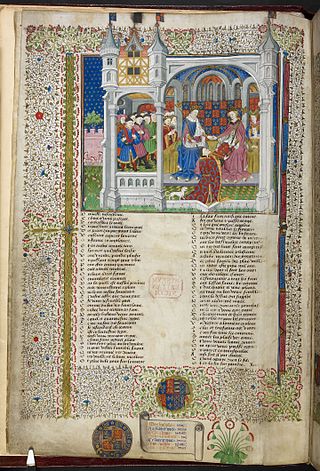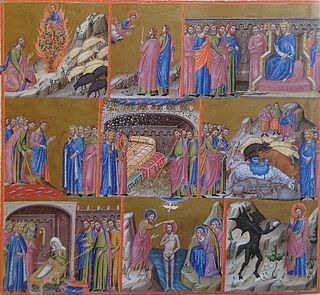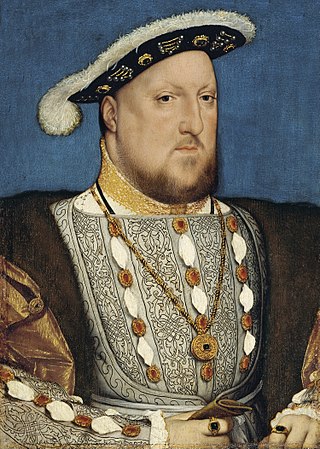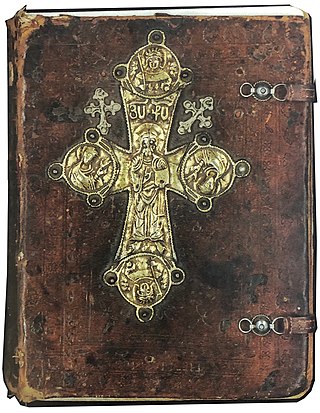
The Hours of Henry VIII is a 15th-century illuminated book of hours, painted by Jean Poyet in Tours. Its 400 pages contain 55 full-page miniatures. It is housed under shelfmark MS H.8 in the Morgan Library & Museum, New York.

The Hours of Henry VIII is a 15th-century illuminated book of hours, painted by Jean Poyet in Tours. Its 400 pages contain 55 full-page miniatures. It is housed under shelfmark MS H.8 in the Morgan Library & Museum, New York.
The Hours of Henry VIII, one of Jean Poyer's best-known works, [1] receives its name from "the possible but unproven eighteenth-century tradition" that it was once owned by King Henry VIII of England. [2] The manuscript belonged to several later English kings including George III. [3]
The manuscript is bound in red velvet. [4] Henry VIII's coat of arms, monogram and motto, "Honi soit qui mal y pense" are contained on the clasps. [5]
On the manuscript's last blank leaf, there is a note supplied by George Wade (1673–1748), one of its owners:
In the Year 1723, being at Mons and hearing of This Book as the greatest Curiosity of its Kind, I found it in the hands of Mons[ieu]r Charle Benoit Desmanet, a Gentl[lema]n of that Town, (and after his Death procured it from his Executors) he Shew’d it me with great care and precaution not Suffering me to touch it, but tur’d over the leaves with a Small pair of Silver Tongues made for that purpose, And perceiving me to Smile at this Nicety, he said with some Warmth, Sir In this manner my Ancestors for above a hundred Years past have preserved this Book from blemish and in the Perfection you now see it; He told me likewise That the Tradition of the Family was That it was formerly A Present from the Emperor Charles the Fifth to Henry the Eighth King of England...

The book of hours is a Christian devotional book used to pray the canonical hours. The use of a book of hours was especially popular in the Middle Ages and as a result, they are the most common type of surviving medieval illuminated manuscript. Like every manuscript, each manuscript book of hours is unique in one way or another, but most contain a similar collection of texts, prayers and psalms, often with appropriate decorations, for Christian devotion. Illumination or decoration is minimal in many examples, often restricted to decorated capital letters at the start of psalms and other prayers, but books made for wealthy patrons may be extremely lavish, with full-page miniatures. These illustrations would combine picturesque scenes of country life with sacred images. Books of hours were usually written in Latin, although there are many entirely or partially written in vernacular European languages, especially Dutch. The closely related primer is occasionally considered synonymous with books of hours, but their contents and purposes could deviate significantly from simply recitation of the canonical hours. Tens of thousands of books of hours have survived to the present day, in libraries and private collections throughout the world.

The Cotton Genesis is a 4th- or 5th-century Greek Illuminated manuscript copy of the Book of Genesis. It was a luxury manuscript with many miniatures. It is one of the oldest illustrated biblical codices to survive to the modern period. Most of the manuscript was destroyed in the Cotton library fire in 1731, leaving only eighteen charred, shrunken scraps of vellum. From the remnants, the manuscript appears to have been more than 440 pages with approximately 340-360 illustrations that were framed and inserted into the text column. Many miniatures were also copied in the 17th century and are now in the Bibliothèque nationale de France in Paris.

Taqwīm aṣ‑Ṣiḥḥa is originally an 11th-century Arab medical treatise by Ibn Butlan of Baghdad. In the West, the work is known by the Latinized name taken by its translations: TacuinumSanitatis. It is a medieval handbook mainly on health, aimed at a cultured lay audience. The text exists in several variant Latin versions, the manuscripts of which are characteristically so profusely illustrated that one student called the Tacuinum "a [300] picture book", only "nominally a medical text". Numerous European versions were made in increasing numbers between the 14th and 15th centuries.

A roll of arms is a collection of coats of arms, usually consisting of rows of painted pictures of shields, each shield accompanied by the name of the person bearing the arms.

The Hours of Catherine of Cleves is an ornately illuminated manuscript in the Gothic art style, produced in about 1440 by the anonymous Dutch artist known as the Master of Catherine of Cleves. It is one of the most lavishly illuminated manuscripts to survive from the 15th century and has been described as one of the masterpieces of Northern European illumination. This book of hours contains the usual offices, prayers and litanies in Latin, along with supplemental texts, decorated with 157 colorful and gilded illuminations. Today, both parts of the manuscript that forms this book are housed at the Morgan Library and Museum in New York City.

Commentary on the Apocalypse is a book written in the eighth century by the Spanish monk and theologian Beatus of Liébana (730–785) and copied and illustrated in manuscript in works called "Beati" during the 10th and 11th centuries AD. It is a commentary on the New Testament Apocalypse of John or Book of Revelation. It also refers to any manuscript copy of this work, especially any of the 27 illuminated copies that have survived. It is often referred to simply as the Beatus. The historical significance of the Commentary is made even more pronounced since it included a world map, which offers a rare insight into the geographical understanding of the post-Roman world. Well-known copies include the Morgan, the Saint-Sever, the Gerona, the Osma and the Madrid Beatus codices.

The British Library is the national library of the United Kingdom and is one of the largest libraries in the world. It is estimated to contain between 170 and 200 million items from many countries. As a legal deposit library, the British Library receives copies of all books produced in the United Kingdom and Ireland, including a significant proportion of overseas titles distributed in the UK. The Library is a non-departmental public body sponsored by the Department for Digital, Culture, Media and Sport.
M. Moleiro Editor is a publishing house specialising in high-quality facsimile reproductions of codices, maps and illuminated manuscripts. Founded in Barcelona in 1991, the firm has reproduced many masterpieces from the history of illumination.

The Hours of Étienne Chevalier is an illuminated book of hours commissioned by Étienne Chevalier, treasurer to king Charles VII of France, from the miniature painter and illuminator Jean Fouquet.

The Black Hours, MS M.493 is an illuminated book of hours completed in Bruges between 1460 and 1475. It consists of 121 pages (leaves), with Latin text written in Gothic minuscule script. The words are arranged in rows of fourteen lines and follow the Roman version of the texts. The lettering is inscribed in silver and gold and placed within borders ornamented with flowers, foliage and grotesques, on pages dyed a deep blueish black. It contains fourteen full-page miniatures and opens with the months of the liturgical calendar, followed by the Hours of the Virgin, and ends with the Office of the Dead.

Jean Poyer, was a French miniature painter and manuscript illuminator of the late 15th century. As a multitalented artist - illuminator, painter, draftsman, and festival designer active from 1483 until his death - he was a painter of Renaissance France, working for the courts of three successive French kings: Louis XI, Charles VIII, and Louis XII.

The Royal manuscripts are one of the "closed collections" of the British Library, consisting of some 2,000 manuscripts collected by the sovereigns of England in the "Old Royal Library" and given to the British Museum by George II in 1757. They are still catalogued with call numbers using the prefix "Royal" in the style "Royal MS 2. B. V". As a collection, the Royal manuscripts date back to Edward IV, though many earlier manuscripts were added to the collection before it was donated. Though the collection was therefore formed entirely after the invention of printing, luxury illuminated manuscripts continued to be commissioned by royalty in England as elsewhere until well into the 16th century. The collection was expanded under Henry VIII by confiscations in the Dissolution of the Monasteries and after the falls of Henry's ministers Cardinal Wolsey and Thomas Cromwell. Many older manuscripts were presented to monarchs as gifts; perhaps the most important manuscript in the collection, the Codex Alexandrinus, was presented to Charles I in recognition of the diplomatic efforts of his father James I to help the Eastern Orthodox churches under the rule of the Ottoman Empire. The date and means of entry into the collection can only be guessed at in many if not most cases. Now the collection is closed in the sense that no new items have been added to it since it was donated to the nation.

The Westminster Psalter, British Library, MS Royal 2 A XXII, is an English illuminated psalter of about 1200, with some extra sheets with tinted drawings added around 1250. It is the oldest surviving psalter used at Westminster Abbey, and is presumed to have left Westminster after the Dissolution of the Monasteries. It joined the Old Royal Library as part of the collection of John Theyer, bought by Charles II of England in 1678. Both campaigns of decoration, both the illuminations of the original and the interpolated full-page drawings, are important examples of English manuscript painting from their respective periods.

The Talbot Shrewsbury Book is a very large richly-illuminated manuscript made in Rouen (Normandy) in 1444/5. It was presented by John Talbot, 1st Earl of Shrewsbury to the French princess, Margaret of Anjou, in honour of her betrothal to King Henry VI. It contains a unique collection of fifteen texts in French, including chansons de geste, chivalric romances, treatises on warfare and chivalry, and finally the Statutes of the Order of the Garter. The work is an excellent example of book production in Rouen in the mid-fifteenth century and provides a rare insight into the political views of the English military leader and close confidant of the crown, John Talbot.

The Great Canterbury Psalter is an early 13th- and mid 14th-century illuminated manuscript with the shelfmark MS lat. 8846 in the Bibliothèque nationale de France in Paris. It was made in two different locations and moments in time: at Canterbury around 1200 and in Catalonia around 1340. It is the last of a series of copies of the Utrecht Psalter made in Canterbury, following the Harley Psalter and the Eadwine Psalter.

The Hours of Joanna I of Castile is a sixteenth-century illuminated codex housed in the British Library, London, under call number Add MS 35313.

The Llanbeblig Book of Hours is an illuminated manuscript in the National Library of Wales that dates from the close of the fourteenth century. Entries in the Calendar link the Llanbeblig Hours to Wales and more specifically the dedication of the church of Saint Peblig, which is marked June 6th, connects it with Caernarfon.

"Green Groweth the Holly", also titled "Green Grow'th the Holly", is a 16th-century English poem and Christmas carol written by King Henry VIII of England. The carol was written as "a carol for three voices".

The Hours of Louis XII was an illuminated manuscript book of hours produced by Jean Bourdichon for Louis XII of France. It was begun in 1498 or 1499, going by the king's age of 36 given below his portrait; he became king on 7 April 1498. The book reached England, where it was broken up around 1700. Now only parts of it survive – in total sixteen full-page miniature paintings, two sheets of text and fifty-one sheets of text bound in the wrong order as a thin volume.

The Zeytun Gospels of 1256 AD is an Armenian illuminated manuscript in the Armenian language by artist and ordained priest T'oros Roslin. The Zeytun Gospels consists of four tabernacles, four evangelists, four namesakes, ornaments and decorations. The manuscript's patron was Catholicos Constantine I of Bardzrberd (1221–1267) and was commissioned for his godson Levon. It was transcribed in a scriptorium at the fortress Hromklay, "the God protected castle", in Cilician Armenia. Hromklay was also known as The School of Miniature Painting at the Catholicosate. The Hromklan scriptorium was at its peak while Roslin worked there on the Zeytun Gospels. The manuscript was later reintroduced as the Zeytun Gospels named after the mountain village of Zeytun during the late Ottoman Empire.